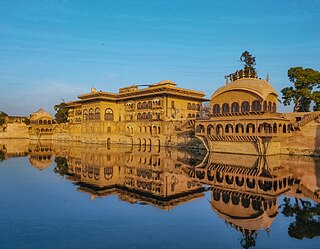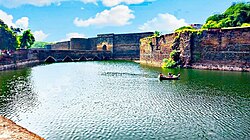
The Agra Fort is a historical fort in the city of Agra, also known as Agra's Red Fort. Mughal emperor Humayun was crowned at this fort in 1530. It was later renovated by the Mughal emperor Akbar from 1565 and the present-day structure was completed in 1573. It served as the main residence of the rulers of the Mughal dynasty until 1638, when the capital was shifted from Agra to Delhi. It was also known as the "Lal-Qila" or "Qila-i-Akbari". Before being captured by the British, the last Indian rulers to have occupied it were the Marathas. In 1983, the Agra fort was inscribed as a UNESCO World Heritage Site because of its importance during Mughal rule. It is about 2.5 kilometers (1.6 mi) northwest of its more famous sister monument, the Taj Mahal. The fort can be more accurately described as a walled city. It was later renovated by Shah Jahan.

Maharaja Suraj Mal, simply known as Suraj Mal, was a Jat ruler of Bharatpur State in the present-day state of Rajasthan. Under him, Bharatpur State, a tributary of the House of Scindia, covered the present-day districts of Agra, Alwar, Aligarh, Bharatpur, Dholpur, Etawa, Hathras, Mainpuri, Meerut, Ghaziabad, Mathura, and Rohtak, Sonipat, Jhajjar, Nuh, Palwal, Faridabad, Kasganj, Mainpuri, Firozabad, Bulandshahr.

Chhatri are semi-open, elevated, dome-shaped pavilions used as an element in Indo-Islamic architecture and Indian architecture. They are most commonly square, octagonal, and round.

Deeg is an ancient historical city in Deeg district of Rajasthan, India. It is carved out from its former district bharatpur on 7 August 2023. It is situated 32 kilometres (20 mi) north of Bharatpur and 98 kilometres (61 mi) northwest of Agra.
Maharani Kishori was the wife of Maharaja Suraj Mal of Bharatpur in Rajasthan, India. She was from Hodal, a town in the modern day Palwal district of Haryana, near Mathura and Bharatpur. The house her husband built for her in Bharatpur is now a monument protected by the government of Rajasthan.

Kumher is a historical town, the initial name of this town was Kuber. It is located in Deeg District of Rajasthan, India.

Badan Singh was the formal founder of the princely state of Bharatpur. He was the nephew of Rao Churaman Singh. After Churaman's death on 20 September 1721 there were family disputes between Badan Singh and Muhkam, son of Churaman. Badan Singh aligned with Jai Singh II of Jaipur to avoid the anger of Muhkam Singh. In this family feud, Jai Singh supported Badan Singh.

Bharatpur District is a district in Rajasthan state in western India. The city of Bharatpur is the District Headquarters, Division Headquarters and Headquarters of Bharatpur

Junagarh Fort is a fort in the city of Bikaner, Rajasthan, India. The fort was originally called Chintamani and was renamed Junagarh or "Old Fort" in the early 20th century when the ruling family moved to Lalgarh Palace outside the fort limits. It is one of the few major forts in Rajasthan which is not built on a hilltop. The modern city of Bikaner has developed around the fort.

Maharaja Jawahar Singh was the ruler of the Bharatpur State. He succeeded to the throne when his father Maharaja Suraj Mal Ji died in 1763.
The Battle of Maonda and Mandholi was fought between the Rajput rulers of Jaipur and the Jat rulers of Bharatpur in 1767 in Rajasthan. Jawahar Singh of Bharatpur was leading an army back from Pushkar when the forces of Madho Singh of Jaipur met them by Maonda and Mandholi villages, near present-day Neem ka Thana. The battle resulted in the rout of the Bharatpur army by the Jaipur forces.

Bharatpur State was a princely state under British suzerainty that was ruled by the Sinsinwar clan of the Hindu Jats. The state was founded by Maharaja Badan Singh in 1722. Suraj Mal played an important role in the development and expansion of the state. At the time of the reign of Suraj Mal (1755–1763), revenue of the state was 17,500,000 gold coins per annum.

The Bhatner Fort was built by son of Rao Bhatti, about 419 km northwest of Jaipur along the old Multan-Delhi route and 230 km north-east of Bikaner. Another name of Hanumangarh was Bhatner, which means "fortress of the Bhati". Believed to be 1700 years old, it is considered to be one of the oldest forts of India.

Kusum Sarovar is a sacred water reservoir with a historic sand monument in its backdrop. It is situated on the holy Govardhan Hill between Manasi Ganga and Radha Kund in Mathura district of Uttar Pradesh, India. Kusum Sarovar is considered one of the sacred spots that witnessed the pastimes of Hindu deities Radha and Krishna. It is also the place of Jat ruler Maharaja Suraj Mal's memorial chhatri. Kusum Sarovar has Narada Kund, where Bhakti Sutra verses were written by Narada and the Shri Radha Vana Bihari Temple in the vicinity.

The Capture of Agra Fort ended a month-long siege by Maharaja Suraj Mal on 12 June 1761. After a one-month siege of Agra the Mughal army, led by Mirza Fazilka Khan, surrendered to the Jat army. The Jat possessed himself of all the wealth of the Mughal Empire and thus became one of the richest man on the planet. The Jats seized the old capital of Mughal Empire. It remained in possession of Bharatpur State rulers until 1774.

The battle of Kumher was fought among Jats, Marathas and Mughals.
The Battle of Delhi (1764) was fought between the Hindu Jat ruler of Kingdom of Bharatpur and the Rohilkhand Kingdom under the Durrani Empire. Maharaja Jawahar Singh of Bharatpur invaded and plundered Delhi along with the help of Marathas of Holkar clan.

Taragarh Fort is a fort located in Bundi, Rajasthan, India. Located high on a hill of aravalli mountain range, it is the principal tourist attraction in Bundi. The fort was built here on a steep hill at a height of 1426 feet. Many tunnels were made in it to exit the fort during the battle. These tunnels are visible at many places in the mountains.
Sinsinwar is an Indian clan of Jats mainly found in the state of Rajasthan, Uttar Pradesh, Madhya Pradesh, Haryana. The name Sinsinwar is derived from the village Sinsini in Bharatpur, Rajasthan. Rulers of the Bharatpur state belong to this clan such as Maharaja Suraj Mal.
Devi Singh was the Rao of Sikar from 1763 until his death in 1795.















